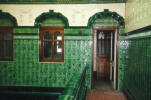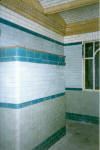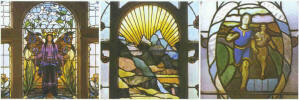2: The Turkish baths

The Corporation had considerable experience in running Turkish baths by 1906. They were already provided at the London Road (Mayfield) and Leaf Street (Hulme) pools which the Corporation had purchased from commercial public baths companies. And they had also been included in the Whitworth baths which the Corporation built in 1890.
Confidence in its newest venture was boldly proclaimed by the stylishness of its furnishings and fittings. At the time of their opening, the local paper reported that,
The Turkish and Russian baths are arranged with fine care for the comforts of roominess and ventilation, and with every provision in the way of douches and sprays that modern tastes demand. These are on the ground floor. One of the cooling-rooms in the basement has been decorated in Oriental style. The decoration of the baths from the elaborate dolphin pattern in the entrance hall to the brass and copper and gun metal fittings and the stained-glass windows, are exceptionally well designed. A coffee-room, a bicycle storage room, and a complete system of electric bells and telephones are some of the special provisions that have been made to give the baths a perfectly up-to-date character. 1
The choice of stained-glass windows and fine woodwork is indicative of the standard of fittings used throughout.
Just about every public area in the building was fully tiled, not merely (as in many public baths) with plain utilitarian tiles, but with patterned and moulded ones, well chosen to suit a variety of different situations.
The tiles may not be quite as richly decorative as those that were to be found in Nevill's London establishments, but taken in combination with the fine woodwork and the many stained-glass windows and door panels, it would be hard to find a more lavish decorative treatment in a publicly funded Turkish bath, used by all classes and both sexes at different times of the day and week.
Within the building, a separate entrance led to Turkish and Russian baths, the bathers first passing through a lobby where they removed and stored their shoes.
The Turkish baths comprised a suite of three increasingly hot rooms, each with glazed brick walls and a vaulted ceiling of the type frequently to be found in Turkish baths of that period.
The hottest room, or laconicum, was sited immediately over the heat exchanger. The hot air entered the room through the top of a tiled shaft which was connected directly to the heat source. It then passed, cooling the while, through open doorways into the other two hot rooms, the caldarium and the tepidarium.
In the years following the re-introduction of the Turkish bath, there was much discussion in the pages of The Lancet and the British Medical Journal about the 'correct' temperatures for each of the hot rooms. Opinions were strongly held, and readers' letters were almost as heated as the disputed temperatures.
But crucially, there was no standardized position for thermometers which were often, as here, too high to indicate the temperature of the air where the seated or recumbent bather's head would normally be.
Also to be found in the suite was a circular needle shower, a drinking fountain (the classic beauty of which even the crude modern replacement tap cannot spoil), a shampooing room and, in the basement, a cooling-room decorated in 'oriental' style.
And during the recent clearing and tidying of the baths undertaken throughout the past year or so, further stained glass panels have been found in the cooling-room which look quite stunning.









